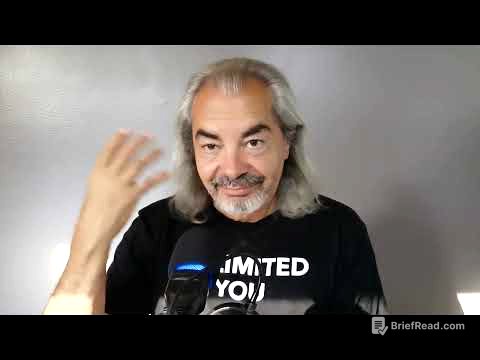TLDR;
This video provides an overview of the Thirty Years' War (1618-1648), a series of conflicts in Europe, primarily within the Holy Roman Empire. It explains the war's origins as a religious conflict, its evolution into a broader political struggle, and the significant impact of the Peace of Westphalia on the European power balance.
- The war began as a religious conflict within the fragmented Holy Roman Empire.
- Political interests and territorial ambitions soon overshadowed the religious aspect.
- The Peace of Westphalia reshaped European power, weakening the Holy Roman Empire and strengthening France and Sweden.
Introduction to the Thirty Years' War [0:00]
The Thirty Years' War (1618-1648) is a significant and complex period in 17th-century European history. It involved a series of conflicts that erupted across Europe, with the Holy Roman Empire as the primary battleground. This war is historically important because it redefined the balance of power in Europe by the mid-17th century. The video will focus on providing an overview of the conflict, explaining its importance, and detailing the changes brought about by the Peace of Westphalia, rather than focusing on individual battles or phases of the war.
Religious Fragmentation in the Holy Roman Empire [0:49]
The Thirty Years' War initially began as a religious war, set against the backdrop of the deeply fragmented Holy Roman Empire. A century earlier, Martin Luther's Protestant Reformation had shaken Germany, leading to civil wars between Protestants and Catholics. The Peace of Augsburg established the principle of cuius regio, eius religio, allowing each ruler within the empire to determine and impose their religion on their subjects. The Holy Roman Empire was a federation of kingdoms and principalities loosely united under an elected emperor.
Ferdinand II and the Defenestration of Prague [1:51]
Ferdinand of Habsburg, later Ferdinand II, played a key role in starting the Thirty Years' War. As a staunch Catholic, Ferdinand inherited the Duchy of Habsburg (present-day Austria), as well as the kingdoms of Hungary and Bohemia. Bohemia, however, had a predominantly Protestant nobility and population. Initially, Protestants in Bohemia were allowed to practice their faith, but when Ferdinand became King of Bohemia in 1617, he began to forcefully impose Catholicism, restricting Protestant worship and showing hostility towards the Protestant nobility. This created significant tension between the Bohemian nobles and their new ruler. In 1619, Ferdinand also became the Holy Roman Emperor. The Defenestration of Prague on 23 May 1618, where Bohemian nobles threw Ferdinand's representatives out of Prague Castle, ignited the Thirty Years' War.
The Bohemian-Palatinate Phase (1618-1625) [5:14]
The first seven years of the war, from 1618 to 1625, were primarily an internal conflict within the Holy Roman Empire, known as the Bohemian-Palatinate phase. The conflict was between Ferdinand II's imperial troops, supported by Catholic princes of Germany and Spanish forces (due to the close ties between the Habsburgs and the Spanish monarchy), and the Bohemian Confederation, led by Protestant princes and the nobility of Bohemia and the Palatinate. The Palatinate, a strongly Protestant state within the empire, joined Bohemia in opposing Emperor Ferdinand II. The Catholic faction, aided significantly by Spanish troops, repeatedly defeated the Protestant forces, notably at the Battle of White Mountain near Prague in 1620.
International Intervention and Shifting Alliances [6:58]
Ferdinand II's victories raised concerns among other European states. By 1625, the conflict transformed from an internal German affair into an international war involving much of Europe. Christian IV, the King of Denmark and Norway, whose kingdom had embraced Protestantism a century earlier, intervened to protect Protestant interests and gain territorial advantages. Paradoxically, Catholic France, under Louis XIII and Cardinal Richelieu, also joined the war against Ferdinand II for political reasons. France, surrounded by Spain and the increasingly powerful Habsburg-dominated Holy Roman Empire, sought to limit Habsburg power.
Swedish Intervention and Continued Conflict [10:01]
Denmark's attempt to challenge the Holy Roman Empire failed, but Sweden, led by Gustavus Adolphus, entered the war around 1630 with a well-prepared army. Gustavus Adolphus died in battle during the conflict. A lull occurred in 1635 with the Peace of Prague after Gustavus Adolphus's death, as Sweden was hesitant to continue the seemingly endless conflict. However, France continued to fight. Ferdinand II died in 1637 and was succeeded by his son, Ferdinand III, who continued the war.
Devastation and the Crisis of the 17th Century [11:30]
The war, lasting 30 years, involved widespread pillaging and violence by mercenary troops, including the Landsknechte. Epidemics, including bubonic plague, spread, exacerbated by the war conditions. The war also intensified an existing economic crisis, leading to demographic collapse, reduced cultivation, and famine. This period is known as the Crisis of the 17th Century, marked by widespread death and suffering, particularly in Germany.
The Peace of Westphalia and its Aftermath [13:21]
Ferdinand III, facing Protestant forces, the French army, the Dutch Republic, and even soldiers from England and Scotland, agreed to end the war in 1648 with the Peace of Westphalia. Although fighting between France and Spain continued for another decade, the Peace of Westphalia significantly reshaped Europe. Sweden and the Dutch Republic were strengthened, with the latter recognised as an independent state. France emerged as the dominant power in Europe, partly due to the de facto dissolution of the Holy Roman Empire. While the empire formally continued, the emperor's power was greatly diminished, becoming largely symbolic. The Habsburgs retained significant power in their territories of Austria, Hungary, and Bohemia, but the Holy Roman Empire became increasingly fragmented politically among various German kingdoms and principalities.









